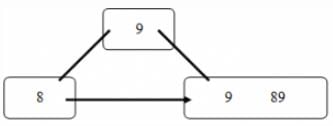Computer Science Engineering (CSE) Exam > Computer Science Engineering (CSE) Tests > Test: B+ Tree - Computer Science Engineering (CSE) MCQ
Test: B+ Tree - Computer Science Engineering (CSE) MCQ
Test Description
10 Questions MCQ Test - Test: B+ Tree
Test: B+ Tree for Computer Science Engineering (CSE) 2025 is part of Computer Science Engineering (CSE) preparation. The Test: B+ Tree questions and answers have been prepared
according to the Computer Science Engineering (CSE) exam syllabus.The Test: B+ Tree MCQs are made for Computer Science Engineering (CSE) 2025 Exam.
Find important definitions, questions, notes, meanings, examples, exercises, MCQs and online tests for Test: B+ Tree below.
Solutions of Test: B+ Tree questions in English are available as part of our course for Computer Science Engineering (CSE) & Test: B+ Tree solutions in
Hindi for Computer Science Engineering (CSE) course.
Download more important topics, notes, lectures and mock test series for Computer Science Engineering (CSE) Exam by signing up for free. Attempt Test: B+ Tree | 10 questions in 30 minutes | Mock test for Computer Science Engineering (CSE) preparation | Free important questions MCQ to study for Computer Science Engineering (CSE) Exam | Download free PDF with solutions
Detailed Solution for Test: B+ Tree - Question 1
Test: B+ Tree - Question 2
A B+ tree can contain a maximum of 7 pointers in a node. What is the minimum number of keys in leaves?
Detailed Solution for Test: B+ Tree - Question 2
Test: B+ Tree - Question 3
A B+ -tree of order 3 is generated by inserting 89, 9 and 8. The generated B+ -tree is __________
Detailed Solution for Test: B+ Tree - Question 3
Detailed Solution for Test: B+ Tree - Question 4
Detailed Solution for Test: B+ Tree - Question 5
Detailed Solution for Test: B+ Tree - Question 6
Detailed Solution for Test: B+ Tree - Question 7
Test: B+ Tree - Question 8
Statement 1: When a node is split during insertion, the middle key is promoted to the parent as well as retained in right half-node.
Statement 2: When a key is deleted from the leaf, it is also deleted from the non-leaf nodes of the tree.
Detailed Solution for Test: B+ Tree - Question 8
Test: B+ Tree - Question 9
What is the maximum number of keys that a B+ -tree of order 3 and of height 3 have?
Detailed Solution for Test: B+ Tree - Question 9
Test: B+ Tree - Question 10
Which one of the following data structures are preferred in database-system implementation?
Detailed Solution for Test: B+ Tree - Question 10
Information about Test: B+ Tree Page
In this test you can find the Exam questions for Test: B+ Tree solved & explained in the simplest way possible.
Besides giving Questions and answers for Test: B+ Tree, EduRev gives you an ample number of Online tests for practice
Download as PDF


















